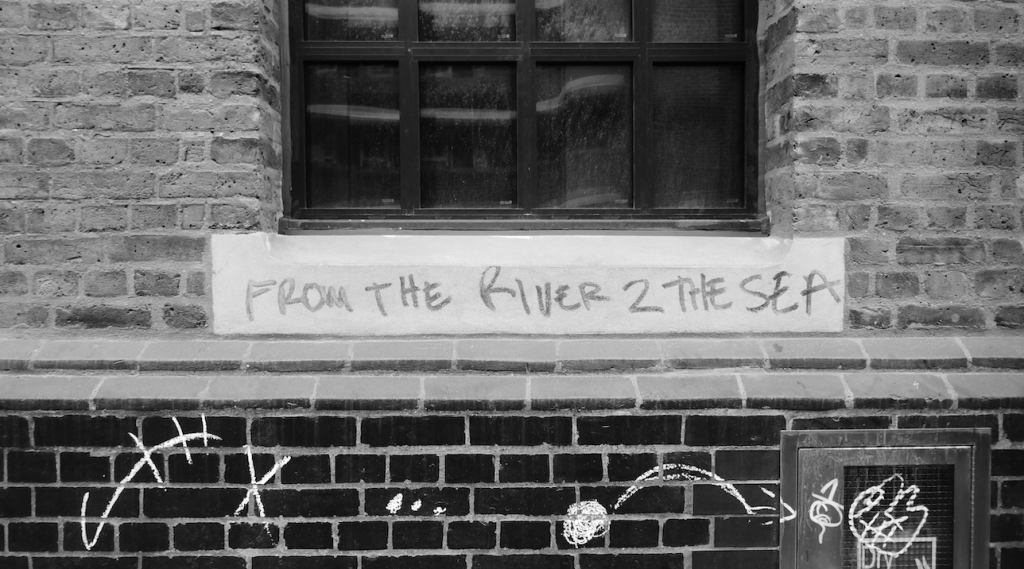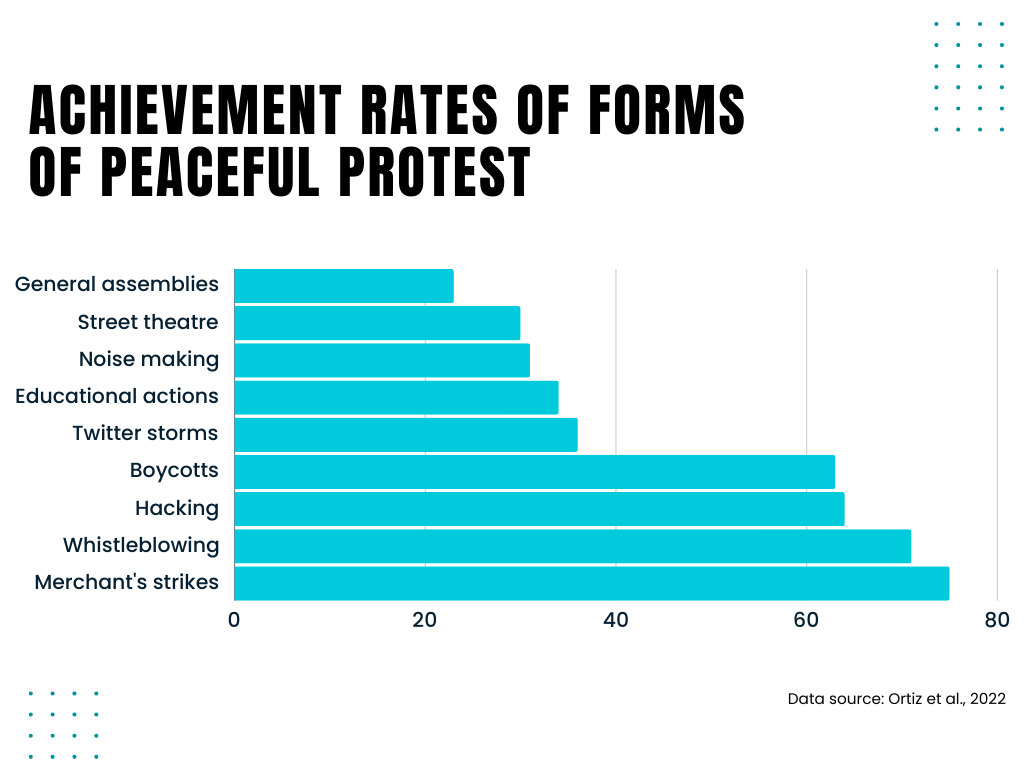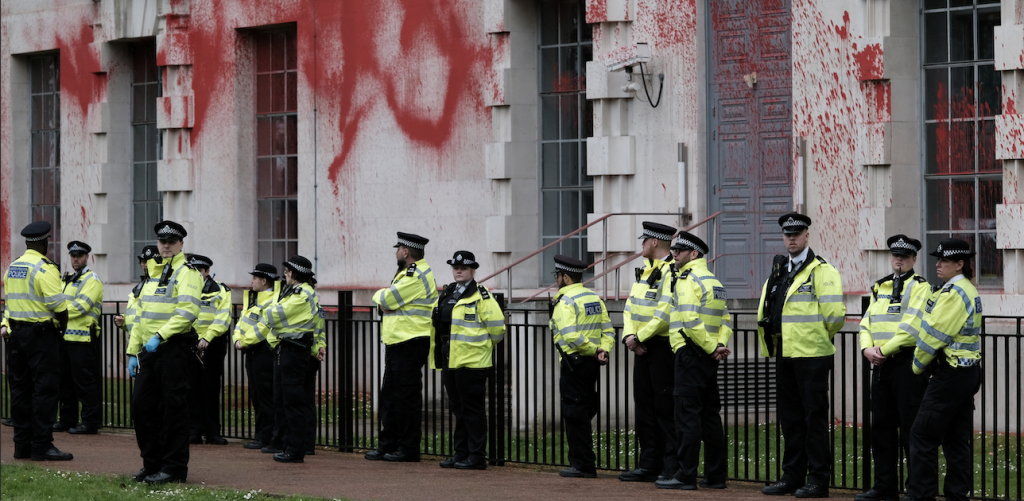Who protests and why: a case study of UK pro-Palestinian protests
Protests are the cornerstone of a healthy democracy, showing the willingness of citizens to politically participate and stand up for causes they believe in. Following the attack on Israel by the armed wing of Hamas, a political and military group which governs the Gaza Strip, on 7 October 2023, Israel has spent the months since bombing the Occupied Palestinian Territory. The attack on Israel was due to decades of Israeli crimes committed against the Palestinian people, including Israeli settlements within the West Bank and East Jerusalem, which are part of Palestine. Since then, frequent protests have taken place across the world and the United Kingdom in support of Palestine. Who protests and why will be examined throughout this blog post, using the example of the widespread pro-Palestinian protests within the UK as a case study.

Pro-Palestine graffiti in London – Cumming, 2024
Grassroots Organisations
Although party support as a motivation for political participation such as protest was visible in decades past, this is no longer the case; this has been replaced by a significant rise in the role of grassroots organisations and social movements. Grassroots organisations such as Boycott, Divestment, Sanctions (BDS) have played a huge role in pro-Palestinian protest. BDS organises targeted consumer boycotts which aim to push for retailers to stop selling products made by companies which profit from Israel’s crimes and those produced on Israeli-occupied land. In Belfast, for example, many protests take place within Lidl, during which protestors remove Israeli-produced products. Boycotts are an old form of protest, and one that is noted for having a particularly high ‘achievement rate’, with political researchers Isabel Ortiz et al. finding that it had one of the highest achievement rates of different forms of protest between 2006 and 2020 at 63% (p. 71). Grassroots organisations are noted as being particularly involved with direct action such as that described above. This has been particularly aided in the information age by the emergence and growth of social media, which has allowed organisers to operationalise action such as this more easily.

Postmaterialism
One of the most common explanations given for the recent growth in the number and size of protests is political disaffection, which is driven by the growth of postmaterialist values (the placing of greater significance on non-material values, such as autonomy, environmentalism, and equality) in younger generations (Inglehart, 1990, p. 47). The emergence of many political youth organisations exemplifies this, such as Youth Demand, a UK youth resistance campaign who demand an arms embargo on Israel and an end to new oil and gas drilling. Alongside Palestine Action, they sprayed red paint over the Ministry of Justice headquarters in London in order to make their demands heard by government. Protests by such groups are an expression of a deep-seated frustration with political systems and the state. This is in part due to the emergence of further postmaterialist values in each generation born since the 1960s, which has led to more critically engaged citizens who are more likely to politically participate on a case-by-case basis when an issue matters to them. This is particularly noteworthy in cases such as those described above, since according to political scientist and postmaterialism theorist Ronald Inglehart, postmaterialist value priorities and age are the two biggest indicators of participation in peace movements (Inglehart, 1990, pp 60-61).

Protests at the Ministry of Justice described above – Hickson, 2024
Cognitive Mobilisation
In contrast to the image of protestors as a disaffected stereotype, another explanation which often presents itself is cognitive mobilisation, which is the development of the political skills necessary to cope with the politics of a large-scale society (Inglehart, 1990, p.44). These skills have become more widespread due to more accessible education and political information, leading to it being perhaps most visible in the student population. Fittingly, students are very involved in the pro-Palestinian protest movement. Recently at Queen’s University Belfast, the QUB Palestine Assembly stood with other universities across Northern Ireland in solidarity with Palestine, tying ribbons with the names of Palestinian university staff who have been murdered by Israel to the gates of the Lanyon Building. According to political researchers Matt Henn et al., non-electoral political participation such as protest is typically made up primarily of those with a higher level of education in recent times. They also note that the political values and practices of today’s young people and particularly students are unusually coherent.
Political participation, and protest in particular, is widespread in the UK at the moment, and it is important to consider and examine the root causes of this behaviour, as who participates and why has implications for what the impact of such protests will be. Grassroots organisations, postmaterialism, and cognitive mobilisation, along with many other factors not explored due to constraints of word count, all work together to drive protest within the UK in the modern day. Protest is one of the most important tools afforded to the general public, allowing for their voice to be heard.
References
BBC News (2023) What is Hamas and why is it fighting with Israel in Gaza?. London, UK: BBC. Available from https://www.bbc.com/news/world-middle-east-67039975 [accessed 21 April 2024].
BDS (2024) Know what to boycott. Palestine: BDS. Available from https://bdsmovement.net/get-involved/what-to-boycott [accessed 19 April 2024].
BDS Belfast (2024) BDS direct actions at Lidl, Home Bargains and Sainsbury’s removing all genocide funding Israeli products from the shelves [Instagram]. 18 April. Available from https://www.instagram.com/reel/C57_xmNobXc/?igsh=YmxnYW53Y29peW5m [accessed 21 April 2024].
Gohil, N. (2024) ‘We’ve built something extraordinary’: six months of UK pro-Palestine marches. The Guardian, 13 April. Available from https://www.theguardian.com/world/2024/apr/13/weve-built-something-extraordinary-six-months-of-uk-pro-palestine-marches [accessed 21 April 2024].
Henn, M., Sloam, J., and Nunes, A. (2022) Young cosmopolitans and environmental politics: how postmaterialist values inform and shape youth engagement in environmental politics. Journal of Youth Studies, 25(6) pp 709-729. Available from https://www.tandfonline.com/doi/abs/10.1080/13676261.2021.1994131 [accessed 18 April 2024].
Inglehart, R. (1990) Values, Ideology, and Cognitive Mobilization in New Social Movements. In: R. J. Dalton and M. Kuechler (eds.) Challenging the Political Order: New Social and Political Movements in Western Democracies. Cambridge, UK: Polity, pp. 43-66.
Norris, P., Walgrave, S., and Van Aelst, P. (2005) Who Demonstrates? Antistate Rebels, Conventional Participants, or Everyone?. Comparative Politics, 37(2) pp 189-205. Available from https://www.jstor.org/stable/20072882 [accessed 19 April 2024].
Ortiz, I., Burke, S., Berrada, M., and Saenz Cortés, H. (2022) World Protests: A Study of Key Protest Issues in the 21st Century [ebook]. Cham, Switzerland: Springer International Publishing. Available from https://link.springer.com/10.1007/978-3-030-88513-7 [accessed 19 April 2024].
Palestine Action (2024) Shut Elbit Down. UK: Palestine Action. Available from https://www.palestineaction.org/[accessed 21 April 2024].
Savage, C. (2024) Pro-Palestine protesters spray red paint over Ministry of Defence building. The Irish News, 10 April. Available from https://www.irishnews.com/news/uk/pro-palestine-protesters-spray-red-paint-over-ministry-of-defence-building-3YBFTTRZ65MTFG5CUBJLEIZIBQ/ [accessed 21 April 2024].
Youth Demand (2024) We’re taking action: sign up below!. UK: Youth Demand. Available from https://youthdemand.org/[accessed 21 April 2024].
Image source (licensed under Creative Commons 2.0)
Cumming, D. (2024) From the river 2 the sea. Available from https://www.flickr.com/photos/34427470616@N01/53475860028 [accessed 21 April 2024].
Hickson, A. (2024) Britain’s MOD sprayed blood red to highlight the UK’s complicity in Israel’s war crimes in Gaza #6. Available from https://www.flickr.com/photos/59952459@N08/53648906870 [accessed 21 April 2024].